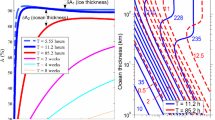Abstract
A new type of SeaFloor ElectroMagnetic Station (SFEMS) has been newly developed by adding a magnetotelluric (MT) variograph to its prototype built previously (Toh and Hamano, 1997). New SFEMS is able to conduct long-term electromagnetic (EM) observations at the seafloor, which is one of the principal goals of the Ocean Hemisphere Project (OHP). Long-term seafloor EM observations enable us to probe into the deep Earth (both the mantle and the core) by improving the spatial coverage of the existing EM observation network. The SFEMS has been tested in three sea experiments to yield 3 components of the geomagnetic field, 2 horizontal components of the geoelectric field and 2 components of tilts in addition to the absolute geomagnetic total force. The SFEMS is designed for measuring these EM signals at the seafloor continuously for as long as 2 yrs.
The SFEMS mainly consists of the following three parts: (1) An Overhauser proton precession magnetometer for the absolute measurements of the geomagnetic total force with a possible bias of less than 10 nT. (2) An MT variograph that measures the rest of the EM components and tilt. (3) An Acoustic Telemetry Modem (ATM) that allows us to control/monitor the seafloor instrument as well as data transmission at the maximum rate of 1200 baud.
Construction of seafloor EM observatories in regions where significant EM data have never been collected is now quite feasible by development of the SFEMS.
Similar content being viewed by others
References
Abragam, A., Principles of Nuclear Magnetism, 599 pp., Oxford Univ. Press, London, 1961.
Chave, A. D., A. W. Green, Jr., R. L. Evans, J. H. Filloux, L. K. Law, R. A. Petitt, Jr., J. L. Rasson, A. Schultz, F. N. Spiess, P. Tarits, M. Tivey, and S. C. Webb, Report of a workshop on technical approaches to construction of a seafloor geomagnetic observatory, Tech. Rep., Woods Hole Oceanogr. Inst., WHOI-95-12, 43 pp., 1995.
De Santis, A., P. Palangio, G. Romeo, P. Favali, G. Smriglio, L. Baranzoli, M. Calcara, G. D’ Anna, G. Etiope, F. Frugori, F. Quattrocchi, and G. Scaleva, The state of GEOSTAR project and its future development, IAGA 97 Abstract Book, p. 461, 1997.
Filloux, J. H., Instrumentation and experimental methods for oceanic studies, in Geomagnetism Vol. I, edited by J. A. Jacobs, pp. 143–248, Academic Press, London, 1987.
Flanagan, M. P. and P. M. Shearer, Global mapping of topography on transition zone velocity discontinuities by stacking SS precursors, J. Geophys. Res., 103, B2, 2673–2692, 1998.
Forsyth, D. W. and A. D. Chave, Experiment investigates magma in the mantle beneath mid-ocean ridges, EOS, 75, 537–540, 1994.
Kasahara, J., H. Utada, and H. Kinoshita, GeO-TOC project-reuse of sub-marine cables for seismic and geoelectrical measurements, J. Phys. Earth, 43, 619–628, 1995.
Lanzerotti, L. J., L. V. Medford, C. G. MaClennan, D. J. Thomson, A. Meloni, and G. P. Gregori, Measurements of the large-scale direct-current Earth potential and possible implications for the geomagnetic dynamo, Science, 229, 47–49, 1985.
Lizarralde, D., A. D. Chave, G. Hirth, and A. Schultz, Northeastern Pacific mantle conductivity profile from long-period magnetotelluric sounding using Hawaii-to-California submarine cable data, J. Geophys. Res., 100, 17837–17854, 1995.
Nolasco, R., P. Tarits, J. H. Filloux, and A. D. Chave, Magnetotelluric imaging of the Society islands hot spot, J. Geophys. Res., 1998 (in press).
Overhauser, A. W., Polarization of nuclei in metals, Phys. Rev., 92, 411–415, 1953.
Perrier, F. E., G. Petiau, G. Clerc, V. Bogorodsky, E. Erkul, L. Jouniaux, D. Lesmis, J. Macnae, J. M. Meunier, D. Morgan, D. Nascimento, G. Oettinger, G. Schwarz, H. Toh, M. J. Valiant, K. Vozoff, and O. Yazici-Cakin, A one-year systematic study of electrodes for long period measurements of the electric field in geophysical environments, J. Geomag. Geoelectr., 49, 1677–1696, 1997.
Schultz, A., R. D. Kurtz, A. D. Chave, and A. G. Jones, Conductivity dis-continuities in the upper mantle beneath a stable craton, Geophys. Res. Lett., 20, 2941–2944, 1993.
Toh, H. and Y. Hamano, The first realtime measurement of seafloor geomagnetic total force-Ocean Hemisphere Project Network, J. Japan Soc. Mar. Surv. Tech., 9, 1–13, 1997.
Toh, H., T. Ichikita, and K. Baba, On the Mantle ELectromagnetic and Tomography experiment, Chikyu Monthly, 18, 429–435, 1996 (in Japanese).
Yokoyama, Y., Thirty year variations in the Earth rotation and the geomagnetic Gauss coefficients, Geophys. Res. Lett., 20, 2957–2960, 1993.
Author information
Authors and Affiliations
Corresponding author
Rights and permissions
About this article
Cite this article
Toh, H., Goto, T. & Hamano, Y. A new seafloor electromagnetic station with an Overhauser magnetometer, a magnetotelluric variograph and an acoustic telemetry modem. Earth Planet Sp 50, 895–903 (1998). https://doi.org/10.1186/BF03352185
Received:
Revised:
Accepted:
Published:
Issue Date:
DOI: https://doi.org/10.1186/BF03352185



